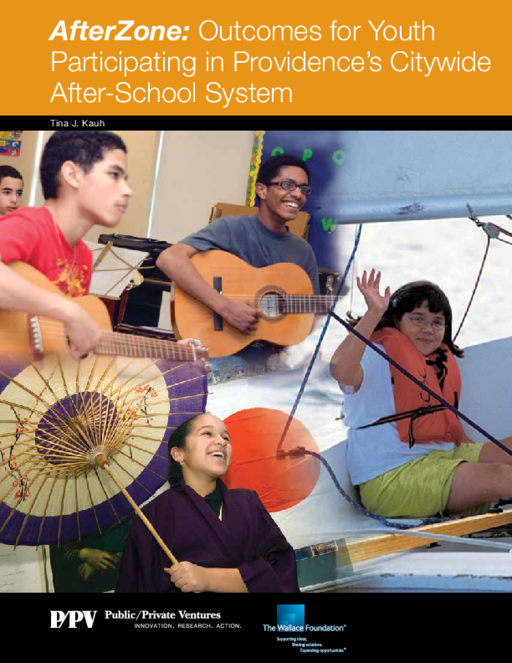Back to Overview
AfterZone
Table of Contents
- Author(s)
- Tina J. Kauh
- Publisher(s)
- Public/Private Ventures
Page Count
92 pages
Research Approach
Findings from this study are based on a sample of 763 youth from six Providence middle schools (the AfterZone anchor schools), who were enrolled in the sixth grade at the start of the study. Nearly half (354 youth) participated in the AfterZone in the sixth grade. Researchers gathered data from three sources: youth surveys, administrative school records and PASA’s management information system (MIS).
- Youth Surveys—Youth surveys were completed three times: in November 2008, May 2009 and May 2010. Each survey collected information on youth background characteristics, including demographics, parental/guardian supervision during the after-school hours, prevalence of life stressors, frequency with which youth must be home after school to care for younger siblings or attend to other responsibilities, and youth’s participation in after-school programming. Researchers also collected data on a wide range of outcome measures, including school-related attitudes, behavior and performance; physical health and nutrition; social and personal skills; and participants’ awareness of and attitudes about their communities. (More details about the specific measures we used are summarized in Appendix A of the full report.)
- Administrative School Records—Administrative data were collected from study participants’ school records at the end of each school year. Information gathered were students’ birth dates; free- or reduced-price lunch status; quarterly grades for English language arts (ELA), math and science courses; proficiency levels on standardized tests in reading and math; and quarterly attendance, tardiness and enrollment data.
- MIS Participation Data—AfterZone participation data were collected at the end of each school year from PASA’s MIS. Researchers collected information about each youth, including the number of days attended, as well as program-level data, such as type of activity offered (skills, arts or sports) and the session (fall, winter or spring).
Data Analysis
Researchers conducted three sets of analyses, examining participation, youth outcomes and the relationship among different dimensions of participation and outcomes.
- Participation Analyses—Researchers conducted an in-depth examination of PASA’s attendance data to assess the level of youth’s sixth and seventh grade participation in the AfterZone. Self-reported data from the youth survey were used to capture youth’s attitudes about the AfterZone experience. These data also provided a snapshot of youth’s participation in afterschool programming outside the AfterZone system. For instance, how many days did youth attend the AfterZone? Did youth participate in the AfterZone consistently throughout the school year by enrolling for multiple sessions? Did youth attend any programs after school that were not part of the AfterZone system?
- Outcome Analyses—This evaluation of the AfterZone relied on a quasi-experimental design that compared the progress youth who participated in the AfterZone made at the end of the sixth and seventh grades with the progress of those who did not. For example, did youth who participated in the AfterZone have better school attendance or demonstrate better social skills than their peers who did not participate?
- Association Between Participation and Outcomes—In addition to using the participations data to describe how much and in what way youth participate in the AfterZone, researchers used those data to examine how varying levels and kinds of participation are associated with youth outcomes.
Topics:


